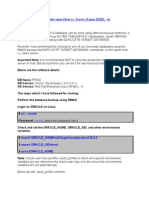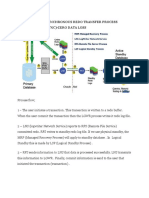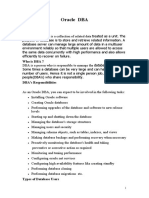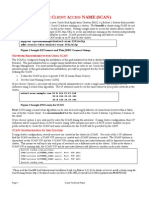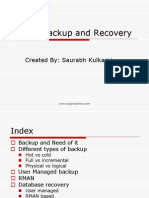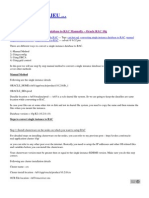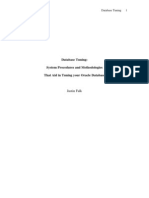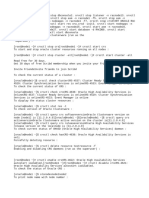How To Backup Oracle Database Using RMAN (With Examples)
Uploaded by
Marco Capac YupanquiHow To Backup Oracle Database Using RMAN (With Examples)
Uploaded by
Marco Capac YupanquiHome Free eBook Start Here Contact About
RSS | Email | Twitter | Facebook | Google+
How to Backup Oracle Database using RMAN
Search
(with Examples)
by RAMESH NATARAJAN on AUGUST 27, 2013
Even if you are not an Oracle DBA, you’ll still encounter a situation where you
may have to take a backup of an Oracle database. EBOOKS
Using Oracle RMAN, you can take a hot backup for your database, which will take Linux 101 Hacks 2nd Edition eBook - Practical
Examples to Build a Strong Foundation in Linux
a consistent backup even when your DB is up and running.
Bash 101 Hacks eBook - Take Control of Your Bash
Command Line and Shell Scripting
This tutorial gives you an introduction on how to perform Oracle DB backup using
RMAN. Sed and Awk 101 Hacks eBook - Enhance Your
UNIX / Linux Life with Sed and Awk
Vim 101 Hacks eBook - Practical Examples for
For the impatient, here is the quick snippet, that takes RMAN backup of both
Becoming Fast and Productive in Vim Editor
database and archive logs.
Nagios Core 3 eBook - Monitor Everything, Be
Proactive, and Sleep Well
RMAN> BACKUP AS BACKUPSET DATABASE PLUS ARCHIVELOG;
1. View Current RMAN Configuration
Before we take the backup, we have to configure certain RMAN parameters. For
example, how long you want to reatain the RMAN backup, etc.
Before we modify any configuration, execute the following command to view all
current RMAN configuration settings.
To connect to RMAN, do the following from command line. This will take you to
RMAN> command prompt, from here you can execute all RMAN commands.
POPULAR POSTS
$ rman target / 15 Essential Accessories for Your Nikon or Canon
Recovery Manager: Release 10.2.0.3.0 - Production on Sat Aug 10 11:21:29 2013 DSLR Camera
Copyright (c) 1982, 2005, Oracle. All rights reserved. 12 Amazing and Essential Linux Books To Enrich
connected to target database: DEVDB (DBID=821773) Your Brain and Library
RMAN> 50 UNIX / Linux Sysadmin Tutorials
50 Most Frequently Used UNIX / Linux
Commands (With Examples)
To view current RMAN configurations, execute “show all”.
How To Be Productive and Get Things Done Using
GTD
RMAN> SHOW ALL; 30 Things To Do When you are Bored and have a
Computer
using target database control file instead of recovery catalog
RMAN configuration parameters are: Linux Directory Structure (File System Structure)
Explained with Examples
CONFIGURE RETENTION POLICY TO RECOVERY WINDOW OF 2 DAYS;
Linux Crontab: 15 Awesome Cron Job Examples
CONFIGURE BACKUP OPTIMIZATION ON;
CONFIGURE DEFAULT DEVICE TYPE TO DISK; Get a Grip on the Grep! – 15 Practical Grep
Command Examples
CONFIGURE CONTROLFILE AUTOBACKUP ON;
CONFIGURE CONTROLFILE AUTOBACKUP FORMAT FOR DEVICE TYPE DISK TO "/backup/rman/ct Unix LS Command: 15 Practical Examples
CONFIGURE DEVICE TYPE DISK BACKUP TYPE TO COMPRESSED BACKUPSET PARALLELISM 2; 15 Examples To Master Linux Command Line
History
CONFIGURE DATAFILE BACKUP COPIES FOR DEVICE TYPE DISK TO 1;
CONFIGURE ARCHIVELOG BACKUP COPIES FOR DEVICE TYPE DISK TO 1; Top 10 Open Source Bug Tracking System
CONFIGURE CHANNEL DEVICE TYPE DISK FORMAT "/backup/rman/full_%u_%s_%p" MAXPIEC Vi and Vim Macro Tutorial: How To Record and
CONFIGURE MAXSETSIZE TO UNLIMITED; Play
CONFIGURE ENCRYPTION FOR DATABASE OFF; Mommy, I found it! -- 15 Practical Linux Find
Command Examples
CONFIGURE ENCRYPTION ALGORITHM 'AES128';
CONFIGURE ARCHIVELOG DELETION POLICY TO NONE; 15 Awesome Gmail Tips and Tricks
CONFIGURE SNAPSHOT CONTROLFILE NAME TO '/u01/app/oracle/product/10.2.0/dbs/snapc 15 Awesome Google Search Tips and Tricks
RAID 0, RAID 1, RAID 5, RAID 10 Explained with
Diagrams
As you see above, it displays various RMAN parameters and their current values. Can You Top This? 15 Practical Linux Top
Command Examples
Top 5 Best System Monitoring Tools
2. Change Few RMAN Configuration Parameters
Top 5 Best Linux OS Distributions
Location: One of the important configuration parameters to set will be, where you How To Monitor Remote Linux Host using Nagios
want to save the RMAN backup. In the following example, I’m settting the RMAN 3.0
backup loacation as “/backup/rman/” Awk Introduction Tutorial – 7 Awk Print Examples
How to Backup Linux? 15 rsync Command
Examples
RMAN> CONFIGURE CHANNEL DEVICE TYPE DISK FORMAT '/backup/rman/full_%u_%s_%p';
The Ultimate Wget Download Guide With 15
Awesome Examples
Retention Period: Next, you should specify how long you want to retain the Top 5 Best Linux Text Editors
backup for. When RMAN takes a backup, it automatically deletes all the old Packet Analyzer: 15 TCPDUMP Command
backups that are older than the retention period. In the following example, I’m Examples
setting the retention period as 7 days, which will keep the DB backup for a week. The Ultimate Bash Array Tutorial with 15
Examples
3 Steps to Perform SSH Login Without Password
RMAN> CONFIGURE RETENTION POLICY TO RECOVERY WINDOW OF 7 DAYS;
Using ssh-keygen & ssh-copy-id
Unix Sed Tutorial: Advanced Sed Substitution
Verify that the above two changes are done. Examples
UNIX / Linux: 10 Netstat Command Examples
The Ultimate Guide for Creating Strong Passwords
RMAN> SHOW ALL;
6 Steps to Secure Your Home Wireless Network
..
CONFIGURE CHANNEL DEVICE TYPE DISK FORMAT '/backup/rman/full_%u_%s_%p'; Turbocharge PuTTY with 12 Powerful Add-Ons
CONFIGURE RETENTION POLICY TO RECOVERY WINDOW OF 7 DAYS;
..
CATEGORIES
Linux Tutorials
Clear a Parameter: If you want to clear a parameter and set its value to default, Vim Editor
use CLEAR at the end of the configuration as shown below. Sed Scripting
Awk Scripting
RMAN> CONFIGURE RETENTION POLICY CLEAR; Bash Shell Scripting
Nagios Monitoring
In this example, since we cleared the retention policy’s value, it was set to the OpenSSH
default value, which is 1. So, the retention policy is set to 1 day as shown below. IPTables Firewall
Apache Web Server
RMAN> SHOW ALL; MySQL Database
CONFIGURE RETENTION POLICY TO REDUNDANCY 1; # default Perl Programming
Google Tutorials
Ubuntu Tutorials
3. Backup Oracle Database PostgreSQL DB
Make sure the directory mentioned in the CHANNEK DEVICE TYPE DISK Hello World Examples
FORMAT is created. i.e /backup/rman/ C Programming
C++ Programming
$ mkdir -p /backup/rman DELL Server Tutorials
Oracle Database
Currently this directory is empty. We’ll see what this has after the backup is taken. VMware Tutorials
$ ls -l /backup/rman
total 0
We can take a backup using image copy or in backup set. It is strongly
recommended to use RMAN backup sets to backup the database.
RMAN stores the backup in backup sets, which are nothing but whole bunch of
files which contains the backed-up data. Only RMAN understands the format of
these files. So, if you backup an Oracle DB using RMAN, only RMAN knows how
to read the backup and restore it.
Typically we’ll use “BACKUP AS BACKUPSET” to backup a database. So, to take a
full backup of the database without the archive logs, do the following.
RMAN> BACKUP AS BACKUPSET DATABASE
To take a full backup of the database with the archive logs, do the following:
RMAN> BACKUP AS BACKUPSET DATABASE PLUS ARCHIVELOG;
You can also take a backup of only a specific table space. The following example
takes backup of only PRD01 tablespace.
RMAN> BACKUP AS BACKUPSET TABLESPACE PRD01;
The RMAN backup output will be something similar to the following:
RMAN> BACKUP AS BACKUPSET DATABASE
Starting backup at 10-AUG-13
using target database control file instead of recovery catalog
allocated channel: ORA_DISK_1
channel ORA_DISK_1: sid=193 devtype=DISK
allocated channel: ORA_DISK_2
channel ORA_DISK_2: sid=192 devtype=DISK
channel ORA_DISK_1: starting full datafile backupset
channel ORA_DISK_1: specifying datafile(s) in backupset
input datafile fno=00025 name=/u03/oradata/devdb/devuser07.dbf
input datafile fno=00003 name=/u02/oradata/devdb/temp01.dbf
channel ORA_DISK_1: starting piece 1 at 10-AUG-13
channel ORA_DISK_2: starting full datafile backupset
channel ORA_DISK_2: specifying datafile(s) in backupset
input datafile fno=00008 name=/u03/oradata/devdb/devusers05.dbf
channel ORA_DISK_2: starting piece 1 at 10-AUG-13
...
..
piece handle=/backup/rman/full_4dogpd0u_4237_1 tag=TAG20130808T114846 comment=NO
channel ORA_DISK_1: backup set complete, elapsed time: 00:00:03
Finished backup at 10-AUG-13
...
Starting Control File and SPFILE Autobackup at 10-AUG-13
piece handle=/backup/rman/ctl_c-758818131-20130808-00 comment=NONE
Finished Control File and SPFILE Autobackup at 10-AUG-13
Once the backup is completed, do an ls on the /backup/rman directory, you’ll now
see RMAN backup files.
$ ls -l /backup/rman
total 14588
-rw-r----- 1 oracle dba 14585856 Aug 8 11:48 ctl_c-758818131-20130808-00
-rw-r----- 1 oracle dba 327680 Aug 8 11:48 full_4dogpd0u_4237_1
Note: Once a backup is taken, to view all available database backups from RMAN,
you need to use “list” command that is shown further down in one of the
examples.
While this may be obvious, it is worth repeating again: Since we are taking
hotbackup, the Oracle database can be up and running. Make sure your Oracle
database is running before you execute any of the above RMAN backup
commands.
4. Assign Backup TAG Name for Quick Identification
If you are taking lot of backups, it will be easier to assign a tag to a particular
backup, which we’ll later use during Oracle recovery (or while using list command
to view it).
The following example assign a backup tag called
“WEEEKLY_PRD01_TBLS_BK_ONLY” to this particular backup.
RMAN> BACKUP AS BACKUPSET TAG 'WEEEKLY_PRD01_TBLS_BK_ONLY' TABLESPACE PRD01;
Starting backup at 10-AUG-13
using channel ORA_DISK_1
using channel ORA_DISK_2
channel ORA_DISK_1: starting full datafile backupset
channel ORA_DISK_1: specifying datafile(s) in backupset
input datafile fno=00002 name=/u03/oradata/devdb/PRD01_1.dbf
channel ORA_DISK_1: starting piece 1 at 10-AUG-13
channel ORA_DISK_1: finished piece 1 at 10-AUG-13
piece handle=/backup/rman/full_4fogpdb3_4239_1 tag=WEEEKLY_PRD01_TBLS_BK_ONLY co
channel ORA_DISK_1: backup set complete, elapsed time: 00:00:01
Finished backup at 10-AUG-13
Starting Control File and SPFILE Autobackup at 10-AUG-13
piece handle=/backup/rman/ctl_c-758818131-20130808-01 comment=NONE
Finished Control File and SPFILE Autobackup at 10-AUG-13
Once the backup is finished, if you view the files from rman directory, you’ll not
see the tag name here. Tag name is used only from RMAN repositories to view and
restore backups. So, now you see there are more files in this directory, as we’ve
taken couple of backups.
$ ls -l /backup/rman/
total 29176
-rw-r----- 1 oracle dba 14585856 Aug 8 11:48 ctl_c-758818131-20130808-00
-rw-r----- 1 oracle dba 14585856 Aug 8 11:54 ctl_c-758818131-20130808-01
-rw-r----- 1 oracle dba 327680 Aug 8 11:48 full_4dogpd0u_4237_1
-rw-r----- 1 oracle dba 327680 Aug 8 11:54 full_4fogpdb3_4239_1
5. Change Oracle RMAN Backup File Name Format
If you want the backup files itself will be in a specific format, you need to change
the format in the RMAN configuration as shown below. In this example, we’ve
appended the tag “full_devdb_bk_” prefix to all our backup files.
RMAN> CONFIGURE CHANNEL DEVICE TYPE DISK FORMAT "/backup/rman/full_devdb_bk_%u
Now, let us take another backup with this modified configuration.
RMAN> BACKUP AS BACKUPSET TAG 'WEEEKLY_PRD01_TBLS_BK_ONLY' TABLESPACE PRD01;
Now when you view the RMAN files, you’ll see the new RMAN backup file has this
new file name format for the files. This is easier to identify certain information
about the backup just by looking at the file names.
$ ls -l /backup/rman/
total 43764
-rw-r----- 1 oracle dba 14585856 Aug 8 11:48 ctl_c-758818131-20130808-00
-rw-r----- 1 oracle dba 14585856 Aug 8 11:54 ctl_c-758818131-20130808-01
-rw-r----- 1 oracle dba 14585856 Aug 8 11:56 ctl_c-758818131-20130808-02
-rw-r----- 1 oracle dba 327680 Aug 8 11:48 full_4dogpd0u_4237_1
-rw-r----- 1 oracle dba 327680 Aug 8 11:54 full_4fogpdb3_4239_1
-rw-r----- 1 oracle dba 327680 Aug 8 11:55 full_devdb_bk_4hogpdef_4241_1
6. Compress a RMAN Backup
If you are taking a backup of a big database, you’ll notice that the RMAN backup
files are bigger (almost same size as the database itself).
So, for most situation, you should always tak ea compressed backup of the
database.
The following example take a compressed backup of the tablepsace PRD01.
RMAN> BACKUP AS COMPRESSED BACKUPSET TAG 'WEEEKLY_PRD01_TBLS_BK_ONLY' TABLESPACE
When you view the backup files from the file system level, you will not see any .gz
(or .zip, or .bz2) to indicate that the RMAN has taken a compressed backup. The
file naming convention will still follow the same as a non-compressed backup.
$ ls -l /backup/rman/
total 58352
-rw-r----- 1 oracle dba 14585856 Aug 8 11:48 ctl_c-758818131-20130808-00
-rw-r----- 1 oracle dba 14585856 Aug 8 11:54 ctl_c-758818131-20130808-01
-rw-r----- 1 oracle dba 14585856 Aug 8 11:56 ctl_c-758818131-20130808-02
-rw-r----- 1 oracle dba 14585856 Aug 8 11:59 ctl_c-758818131-20130808-03
-rw-r----- 1 oracle dba 327680 Aug 8 11:48 full_4dogpd0u_4237_1
-rw-r----- 1 oracle dba 327680 Aug 8 11:54 full_4fogpdb3_4239_1
-rw-r----- 1 oracle dba 327680 Aug 8 11:55 full_devdb_bk_4hogpdef_4241_1
-rw-r----- 1 oracle dba 127680 Aug 8 11:59 full_devdb_bk_4jogpdl0_4243_1
Note: The way to tell whether RMAN has take a compressed backup or not, it by
looking at the size, and by looking at the output of the RMAN “list” command
which is shown in one of the section below.
7. View all RMAN Backups
To view all the RMAN backups, execute “list backup summary” as shown below.
RMAN> LIST BACKUP SUMMARY;
using target database control file instead of recovery catalog
List of Backups
===============
Key TY LV S Device Type Completion Time #Pieces #Copies Compressed Tag
------- -- -- - ----------- --------------- ------- ------- ---------- ---
..
4215 B F A DISK 10-AUG-13 1 1 NO TAG201308
4216 B F A DISK 10-AUG-13 1 1 NO TAG201308
4217 B F A DISK 10-AUG-13 1 1 NO WEEEKLY_P
4218 B F A DISK 10-AUG-13 1 1 NO TAG201308
4219 B F A DISK 10-AUG-13 1 1 NO WEEEKLY_P
4220 B F A DISK 10-AUG-13 1 1 NO TAG201308
4221 B F A DISK 10-AUG-13 1 1 YES WEEEKLY_P
As you see above, it displays various information about the backups. In the above
output, it show 7 RMAN backups. The last column shows the “Tag” that we
specified when we took a backup. If we didn’t specify any TAG, RMAN creates a
default tag with the prefix “TAG” followed by some numbers. You can also see that
under the column “Compressed”, the last RMAN backup shows “YES”, which
indicates that out of all the 7 RMAN backups, only the last one was compressed.
Also, when the RMAN backup is running, if you want to see the proress, you can
query the V$RMAN_STATUS table from sql*plus as shown below.
SQL> SELECT OPERATION, STATUS, MBYTES_PROCESSED, START_TIME, END_TIME from V$RMA
OPERATION STATUS MBYTES_PROCESSED START
--------------------------------- ----------------------- ---------------- -----
CONTROL FILE AND SPFILE AUTOBACK COMPLETED 14 07-NO
RMAN COMPLETED 0 07-NO
RESTORE VALIDATE COMPLETED 0 07-NO
RMAN COMPLETED WITH ERRORS 0 07-NO
DELETE COMPLETED 0 08-NO
BACKUP COMPLETED 0 10-AU
CONTROL FILE AND SPFILE AUTOBACK COMPLETED 14 10-AU
RMAN COMPLETED WITH ERRORS 1832 10-AU
RMAN COMPLETED 0 10-AU
...
There you have it!. That is how you take an Oracle RMAN backup and sleep
peacefully.
> Add your comment
If you enjoyed this article, you might also like..
1. 50 Linux Sysadmin Tutorials Awk Introduction – 7 Awk Print
2. 50 Most Frequently Used Linux Examples
Commands (With Examples) Advanced Sed Substitution
3. Top 25 Best Linux Performance Examples
Monitoring and Debugging Tools 8 Essential Vim Editor Navigation
4. Mommy, I found it! – 15 Practical Linux Fundamentals
Find Command Examples 25 Most Frequently Used Linux
5. Linux 101 Hacks 2nd Edition eBook IPTables Rules Examples
Turbocharge PuTTY with 12
Powerful Add-Ons
Tagged as: RMAN Backup Command, RMAN Backup Controlfile, RMAN Backup Datafile, RMAN Backup Format, RMAN Backup
Location, RMAN Backup Syntax, RMAN Backup to Disk
{ 55 comments… add one }
Jalal Hajigholamali August 27, 2013, 8:49 am
Hi,
Very useful article for DBA
Thanks
LINK
Selvam August 27, 2013, 9:23 am
Very Nice! Thanks.
LINK
A.Baines August 27, 2013, 11:39 am
Great stuff I can always use info like this.
LINK
Astorre August 28, 2013, 1:49 am
Good article ! Thanks.
I hope to see others articles on the same usefull topic. 🙂
LINK
dudex00F August 30, 2013, 2:00 am
thanks for the hints, however RMAN backup seems to be working only
when an Oracle instance is up, thus can it be used against disaster recovery?
will you cover RMAN process?
LINK
Tasslehoff September 2, 2013, 6:56 am
Great post, very useful!
Do you think to cover also the restore procedure with RMAN?
One more question, if I remember RMAN backup is possibile only if the Oracle
database is running in archive mode, is it right?
LINK
Mahfuz September 9, 2013, 11:40 am
@Tasslehoff
RMAN can make consistent and inconsistent backup,incremental or full
backup,backup of whole or portion of database.
LINK
Anonymous October 28, 2013, 11:38 am
Rman scenarios please
LINK
Tomas Kirsten November 14, 2013, 1:50 am
yes, more scenarios please espc. to disaster recovery
cheers all DBAs
LINK
Delwar November 19, 2013, 4:55 am
Useful article.Thanks.
LINK
shanmugam January 21, 2014, 6:33 am
Hi,
is there any view to check the retention time of the existing back in the catalog?
LINK
Naveen Sunkari February 4, 2014, 10:18 pm
Hi
Very usefull i am working on Netbackup in IBM and in my present environment
we dont have RMAN backups, but i am interested to know about this. i am new
and fresh to this concept, now i got clear idea on Data base backups. its very
usefull information for all those who are new to RMAN backups.
Thank you so much for sharing..
LINK
Bijayalaxmi Behera March 4, 2014, 10:59 pm
Hi, it is very useful for me.Thanx
LINK
prasad May 19, 2014, 8:39 am
Nice pls update more scenerios for practice please.
LINK
Rezaul June 6, 2014, 3:21 pm
Very usefull information about RMAN.
LINK
Anonymous June 12, 2014, 4:32 am
Very usefull information about RMAN.
LINK
Manoj June 19, 2014, 12:56 pm
Super Thanks. Excellent article, please keep posting more and more 🙂
LINK
abhishek July 14, 2014, 2:56 am
very impressive article….would you please more elaborate this topic..how
to recover RMAN backup…or some other topic ie: migrate oracle DB from
Linux(R.H.E.L) to UNIX(A.I.X).
LINK
Vishan July 15, 2014, 12:08 am
Simple and very helpful…cheers…!!!
LINK
manfred August 17, 2014, 8:01 am
your tutorial help me a lot
can you cover the recovery process after backing up the database ??
thanks
LINK
cithu August 24, 2014, 7:37 am
Thanks for your tutorial. simple and useful.
LINK
sundar September 9, 2014, 2:02 am
thanks a lot
LINK
Raj September 15, 2014, 10:03 pm
Thanks and useful content
LINK
Shalini Singh October 5, 2014, 12:44 am
Really useful:-)
LINK
ramana October 17, 2014, 2:39 pm
it’s very nice tutorial.It will very helpfull for beginners and experienced
LINK
Dave Bowers October 30, 2014, 10:54 am
I am trying to do a database backup to disk and I am using the
instruction in this post but I continue to have the following error message:
RMAN-03009: failure of backup command on ORA_DISK_1 channel at
10/30/2014 11:46:29
ORA-07217: sltln: environment variable cannot be evaluated.
I have added the suggested parameters to RMAN.
I have ORACLE_SID and ORACLE_HOME set.
What variable am I missing?
LINK
Junaid November 11, 2014, 1:16 am
It is very nice. Elaborated nicely each and every thing
Regards, J
LINK
Orcl November 14, 2014, 5:13 pm
very useful thank you.
LINK
Anthony December 5, 2014, 6:57 am
Hi,
Thx for the post I am trying this on the test instance I am getting the following
errror
BACKUP AS BACKUPSET DATABASE PLUS ARCHIVELOG;
Starting backup at 05-DEC-14
ORACLE error from target database:
ORA-00258: manual archiving in NOARCHIVELOG mode must identify log
allocated channel: ORA_DISK_1
channel ORA_DISK_1: SID=2860 device type=DISK
specification does not match any archived log in the recovery catalog
backup cancelled because all files were skipped
Finished backup at 05-DEC-14
Starting backup at 05-DEC-14
using channel ORA_DISK_1
channel ORA_DISK_1: starting full datafile backup set
channel ORA_DISK_1: specifying datafile(s) in backup set
RMAN-03009: failure of backup command on ORA_DISK_1 channel at
12/05/2014 21:01:49
ORA-19602: cannot backup or copy active file in NOARCHIVELOG mode
continuing other job steps, job failed will not be re-run
channel ORA_DISK_1: starting full datafile backup set
channel ORA_DISK_1: specifying datafile(s) in backup set
including current control file in backup set
channel ORA_DISK_1: starting piece 1 at 05-DEC-14
channel ORA_DISK_1: finished piece 1 at 05-DEC-14
piece handle=/mnt/anthony/rman/full_08ppea9t_8_1
tag=TAG20141205T210148 comment=NONE
channel ORA_DISK_1: backup set complete, elapsed time: 00:00:01
RMAN-00571:
========================================================
===
RMAN-00569: =============== ERROR MESSAGE STACK FOLLOWS
===============
RMAN-00571:
========================================================
===
RMAN-03002: failure of backup plus archivelog command at 12/05/2014
21:01:52
RMAN-03009: failure of backup command on ORA_DISK_1 channel at
12/05/2014 21:01:49
ORA-19602: cannot backup or copy active file in NOARCHIVELOG mode
LINK
Tasslehoff December 5, 2014, 4:50 pm
@Anthony
It’s normal, you can use rman only if the database is working in archive log mode.
Connect to your db as sysdba with a client (sqlplus or sql developer or any other)
and lauch “archive log list”.
It will return some information, “Database log mode” will tell you if your database
works in archive log mode or no archive log.
Probably yours will work in no archive log, you can change it but you must create
a directory for archivelogs and tell the database to use that directory.
LINK
Charles Martel March 9, 2015, 3:52 pm
This was the best documentation on Rman to be found on the web. It’s
far more concise and useful than anything that I saw on the Oracle sites. Oracle –
if you read this- please take note of the practical nature of this man’s work.
Mr NATARAJAN – THANK YOU ! You have saved my week and perhaps my
whole work with Oracle.
LINK
Rahul March 18, 2015, 5:39 am
Hi friend,
if you have some more details about logical backup and physical backup please
inform.
LINK
Abdul Hamed June 5, 2015, 2:18 pm
Very useful …more
LINK
Alok July 3, 2015, 1:02 am
Very Very useful
LINK
Antim July 15, 2015, 5:16 am
Really it was help full article, Specially for those have started their carrier
recently in oracle DBA field.
LINK
PC July 30, 2015, 12:33 am
Thanks..
LINK
laxmi August 1, 2015, 1:34 am
many thanks…very useful
LINK
Lorena August 4, 2015, 6:42 am
Very helpfull !Thanks 😀
LINK
tpen August 28, 2015, 11:02 am
It is nice article on RMAN, and most of people getting the error, they
should make sure that RMAN is achivelog enable mode, before they can use
RMAN for fully backup
LINK
Chathuranga September 26, 2015, 7:34 am
really helpful thankxx mate…
LINK
Nos October 2, 2015, 8:33 am
Nice, accurate and concise, to the point. enjoyable reading.
Great job !!
LINK
Nelson November 11, 2015, 10:57 am
Thank you. Still relevant and very useful.
LINK
Waseem November 30, 2015, 4:57 am
Very useful and helpful artical
LINK
GIANGTD December 23, 2015, 3:48 am
Thanks alot
LINK
hamma March 8, 2016, 9:09 am
thanks
LINK
hoanguyentvn March 28, 2016, 3:51 am
Love your article so much!!! very useful for me…thank you!
LINK
Krishna April 1, 2016, 12:11 am
Thanks for this article on backup and RMAN in Database. This gives a
basic understanding how backup are done at DB level for non-DBA support team
even though we depend on DB.
LINK
Sam April 6, 2016, 8:19 pm
Excellent one
LINK
ali May 18, 2016, 3:05 am
keep it up! keep sharing this kind of articles very useful…..
LINK
Lamine May 29, 2016, 1:30 pm
That’s awesome. I thank you …
LINK
Naveen December 14, 2016, 3:04 am
Could you please provide me the steps to backup oracle 11g database and
its objects on a windows 7 32 bit machine. Further i would like to keep it as a
archive and day to day basis.
LINK
Basavaraj Hiremath December 24, 2016, 12:57 pm
Very useful article on RMAN backup concepts with precise examples..
well done !!
LINK
Priyanka January 20, 2017, 9:40 am
Excellent..!!!
LINK
Tanay Lakshman February 22, 2017, 11:39 pm
Useful
LINK
Anonymous March 24, 2017, 3:56 am
Good One..!
LINK
Leave a Comment
Name
Website
Comment
Save my name, email, and website in this browser for the next time I comment.
Submit
Notify me of followup comments via e-mail
Next post: How to Setup F5 HTTPS SSL Load Balancing in Big-IP
Previous post: How to Enable SSH on Cisco Switch, Router and ASA
A T G S C U S U
My name is Ramesh Email Me : Use this Contact Form to get in Support this blog by purchasing one of my
Natarajan. I will be touch me with your comments, questions or ebooks.
posting instruction guides, suggestions about this site. You can also
how-to, troubleshooting simply drop me a line to say hello!. Bash 101 Hacks eBook
tips and tricks on Linux,
database, hardware, Follow us on Google+ Sed and Awk 101 Hacks eBook
security and web. My focus is to write
articles that will either teach you or help Follow us on Twitter Vim 101 Hacks eBook
you resolve a problem. Read more about
Ramesh Natarajan and the blog. Become a fan on Facebook Nagios Core 3 eBook
Copyright © 2008–2021 Ramesh Natarajan. All rights reserved | Terms of Service
You might also like
- LA Oracle Users Group: Succeeding With RMANNo ratings yetLA Oracle Users Group: Succeeding With RMAN26 pages
- Single Client Access Name (SCAN) Oracle RAC 11gR2No ratings yetSingle Client Access Name (SCAN) Oracle RAC 11gR23 pages
- Hot Backup:: For This We Need To Store Archive LogsNo ratings yetHot Backup:: For This We Need To Store Archive Logs4 pages
- Oracle Dataguard Support Issues: Brian Hitchcock Ocp 10G Dba Sun MicrosystemsNo ratings yetOracle Dataguard Support Issues: Brian Hitchcock Ocp 10G Dba Sun Microsystems76 pages
- Raccheck - Rac Configuration Audit Tool (Id 1268927.1) : 30-May-2013 Script Published 1No ratings yetRaccheck - Rac Configuration Audit Tool (Id 1268927.1) : 30-May-2013 Script Published 18 pages
- Business Continuity For EBS Using Oracle 11g Physical Standby DB (Oracle E-Business Suite Technology)No ratings yetBusiness Continuity For EBS Using Oracle 11g Physical Standby DB (Oracle E-Business Suite Technology)7 pages
- Database Tuning: System Procedures and Methodologies That Aid in Tuning Your Oracle DatabaseNo ratings yetDatabase Tuning: System Procedures and Methodologies That Aid in Tuning Your Oracle Database21 pages
- Step by Guide Rman For Dataguard-ID 469493.1No ratings yetStep by Guide Rman For Dataguard-ID 469493.111 pages
- Standby Database Checklist: 1. OverviewNo ratings yetStandby Database Checklist: 1. Overview13 pages
- General Backup and Recovery Questions: Why and When Should I Backup My Database?100% (1)General Backup and Recovery Questions: Why and When Should I Backup My Database?16 pages
- Webinar - 04 - TDE Live Implementation On 19c RACNo ratings yetWebinar - 04 - TDE Live Implementation On 19c RAC14 pages
- 7 Easy Steps To Configure HugePages For Your Oracle Database ServerNo ratings yet7 Easy Steps To Configure HugePages For Your Oracle Database Server5 pages
- High-Performance Oracle: Proven Methods for Achieving Optimum Performance and AvailabilityFrom EverandHigh-Performance Oracle: Proven Methods for Achieving Optimum Performance and AvailabilityNo ratings yet
- Oracle RMAN for Absolute Beginners 1st Edition Darl Kuhn instant download100% (1)Oracle RMAN for Absolute Beginners 1st Edition Darl Kuhn instant download52 pages
- Oracle RMAN for Absolute Beginners 1st Edition Darl Kuhn - Quickly download the ebook in PDF format for unlimited reading100% (2)Oracle RMAN for Absolute Beginners 1st Edition Darl Kuhn - Quickly download the ebook in PDF format for unlimited reading47 pages
- How To Download Web of Science Data For Bibliometrics ResearchNo ratings yetHow To Download Web of Science Data For Bibliometrics Research12 pages
- (Ebooks PDF) Download (Original PDF) Experiencing MIS, 5th Canadian Edition by David M. Kroenke Full Chapters100% (8)(Ebooks PDF) Download (Original PDF) Experiencing MIS, 5th Canadian Edition by David M. Kroenke Full Chapters41 pages
- Sap Business Studio - Admin and Dev ConfigNo ratings yetSap Business Studio - Admin and Dev Config178 pages
- Btec l3 Ict 31761 Part A and B CombinedNo ratings yetBtec l3 Ict 31761 Part A and B Combined20 pages
- Windows Powershell - Management of Active Directory InfrastructureNo ratings yetWindows Powershell - Management of Active Directory Infrastructure3 pages
- Practice Problems 3 (Data Description For Online) PDFNo ratings yetPractice Problems 3 (Data Description For Online) PDF2 pages
- Database Engineering Summary of Coursework-1No ratings yetDatabase Engineering Summary of Coursework-14 pages
- GIS-based Locational Analysis of Collection Bins in Municipal Solid Waste Management SystemsNo ratings yetGIS-based Locational Analysis of Collection Bins in Municipal Solid Waste Management Systems6 pages
- 55 Google Sheets Interview Questions To Ask Candidates With Answers 1726054403307msnNo ratings yet55 Google Sheets Interview Questions To Ask Candidates With Answers 1726054403307msn1 page
- APEO Free Report (Pre Treat Zip) 68141440341No ratings yetAPEO Free Report (Pre Treat Zip) 681414403413 pages
- AME For Invoice Approval (1) Very Good OneNo ratings yetAME For Invoice Approval (1) Very Good One27 pages
- Consommer Une Calculation View Avec Procedure Stockée Et CDS Table Function Et Paramètres Avec Une Views A DefinirNo ratings yetConsommer Une Calculation View Avec Procedure Stockée Et CDS Table Function Et Paramètres Avec Une Views A Definir15 pages
- Database Management System (DBMS) Project On The Topic "Online Music Library"No ratings yetDatabase Management System (DBMS) Project On The Topic "Online Music Library"30 pages




